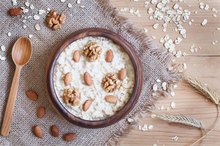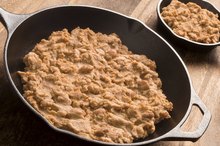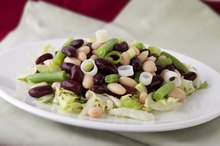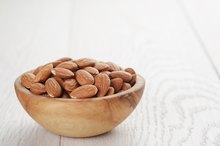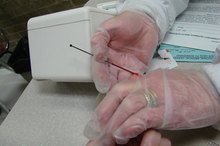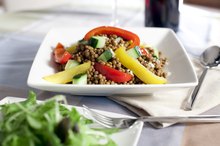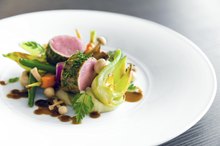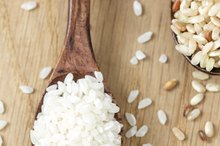1,200-Calorie Exchange Diet
The exchange diet is a system of controlling portion sizes from each food group to help manage diabetes. Each “exchange,” or serving, from the same food group has similar effects on your blood sugar, meaning you can swap one food for another within the same group. To stay within your 1,200-calorie-per-day allowance, you’ll need to make sure you know how many exchanges you can have from each group and measure out each portion.
Starches and Breads
Based on a 1,200-calorie diet, you can have five servings of starch and bread. One exchange is equivalent to 1/2 cup of cooked cereal like oatmeal or 1/2 cup of prepared pasta or rice. Or you can have 1 ounce of bread, which is usually one slice of bread, half an English muffin or one 6-inch pita round. Starchy veggies fit into this exchange group as well. A single exchange of potatoes, winter squash, parsnips, corn or green peas is 1/2 cup, or 4 ounces. Ideally, at least three of your exchanges should come from whole-grain foods 2.
- Based on a 1,200-calorie diet, you can have five servings of starch and bread.
- Or you can have 1 ounce of bread, which is usually one slice of bread, half an English muffin or one 6-inch pita round.
Meat, Fish, Seafood and Protein Foods
2,000-Calorie ADA Diet Plan
Learn More
You’re allowed to have four exchanges from the meat group. All of your exchanges should come from lean sources to minimize your intake of saturated fat, which can lead to high cholesterol. One exchange of lean meat is equivalent to 1 ounce of cooked chicken, turkey, beef sirloin, veal chop, lamb leg or fish. A 1-ounce exchange could also be six medium oysters, two small sardines or an ounce of crab, lobster or shrimp. Eggs fit into this group, with a whole egg amounting to one exchange. Or swap that whole egg for two egg whites. Even cheese takes up some of your meat allotment. One-quarter cup of cottage cheese, 1 ounce of feta or an ounce of reduced-fat cheddar or mozzarella amount to one exchange. One-half cup of cooked beans or lentils takes up one meat exchange plus one starch exchange.
- You’re allowed to have four exchanges from the meat group.
- A 1-ounce exchange could also be six medium oysters, two small sardines or an ounce of crab, lobster or shrimp.
Dairy Foods
Your 1,200-calorie exchange plan includes two exchanges from the dairy group. Eight ounces of milk amounts to one exchange of dairy, as does 1 cup of yogurt. However, your dairy selections should be either fat-free or 1 percent varieties so you don’t get too much saturated fat or calories in your diet. Also, if you do have yogurt as an exchange from this group, read the label carefully to ensure it has no added sugar.
- Your 1,200-calorie exchange plan includes two exchanges from the dairy group.
- Also, if you do have yogurt as an exchange from this group, read the label carefully to ensure it has no added sugar.
Fruits and Nonstarchy Vegetables
Are Refried Beans Starch or Protein?
Learn More
You’ll want to have three exchanges of fruit and two exchanges of nonstarchy vegetables each day. An exchange of fruit generally equals one small 4-ounce piece of whole fruit, like an apple, banana or an orange, or 1/2 cup of unsweetened canned fruit. Two tablespoons of no-sugar-added dried fruit can be an alternative for a fruit exchange as well. Nonstarchy vegetables include:
- lettuce
- spinach
- cucumbers
- carrots
- eggplant
- onions
- peppers
- cauliflower
- broccoli
One exchange is 1 cup of raw vegetables or 1/2 cup of cooked veggies. Fruit or vegetable juice fit into this exchange group, too. But ensure that your 1/2-cup exchange serving is 100 percent juice.
- You’ll want to have three exchanges of fruit and two exchanges of nonstarchy vegetables each day.
- An exchange of fruit generally equals one small 4-ounce piece of whole fruit, like an apple, banana or an orange, or 1/2 cup of unsweetened canned fruit.
Fat Allotment
Limit yourself to just three exchanges from the fat group for a 1,200-calorie plan. Your fats should all be from heart-healthy monounsaturated and polyunsaturated fats, which often come from plant sources. One exchange of nuts is six almonds or cashews, three macadamia nuts, four pecan halves, 10 peanuts or 16 pistachios. Or you can swap that nut exchange for eight large black olives 2. A 2-tablespoon, or 1-ounce, serving of avocado amounts to one exchange of fat. Each 1-teaspoon drizzle of canola, olive, flaxseed, soybean, sunflower or other vegetable-based oil you have also equates to one exchange.
- Limit yourself to just three exchanges from the fat group for a 1,200-calorie plan.
- Each 1-teaspoon drizzle of canola, olive, flaxseed, soybean, sunflower or other vegetable-based oil you have also equates to one exchange.
Related Articles
References
- University of Maryland Medical Center: Diabetes Diet
- Choose Your Foods: Exchange Lists for Weight Loss; Academy of Nutrition and Dietetics
- Wheeler M, Daly A, Evert A et al. Choose your foods: exchange lists for diabetes, sixth edition, 2008: description and guidelines for use. J Am Diet Assoc. 2008;108(5):883-888. doi:10.1016/j.jada.2008.02.002
- University of California, San Francisco. Diabetes Education Online. Carbohydrate exchanges.
Writer Bio
Melodie Anne Coffman specializes in overall wellness, with particular interests in women's health and personal defense. She holds a master's degree in food science and human nutrition and is a certified instructor through the NRA. Coffman is pursuing her personal trainer certification in 2015.
